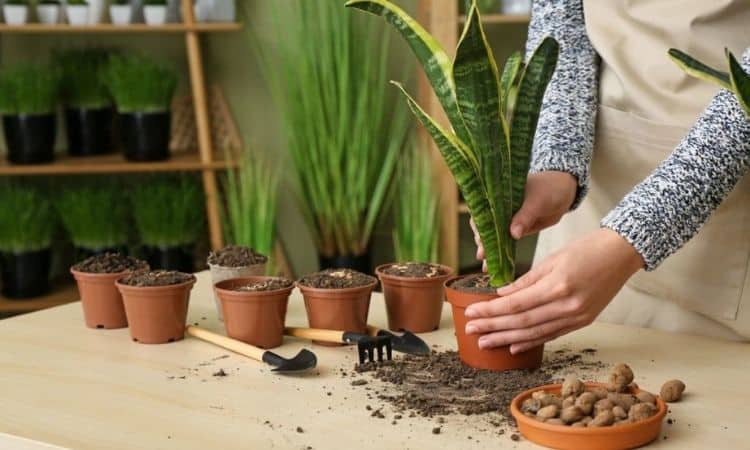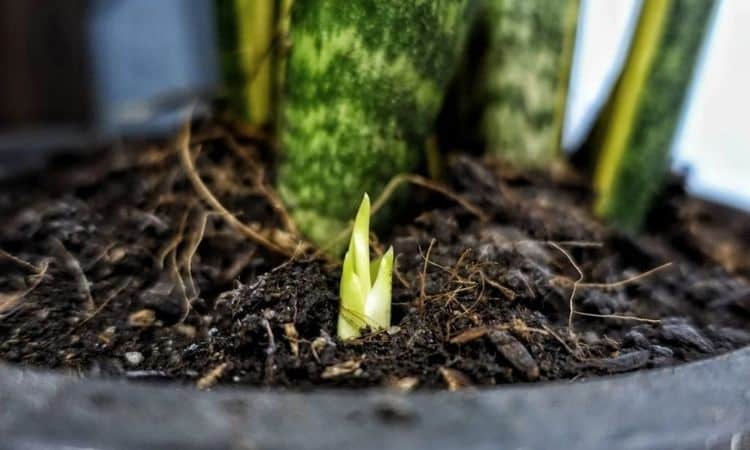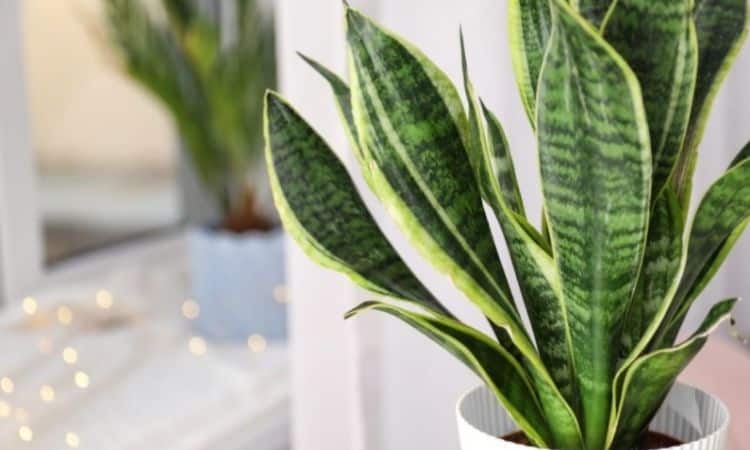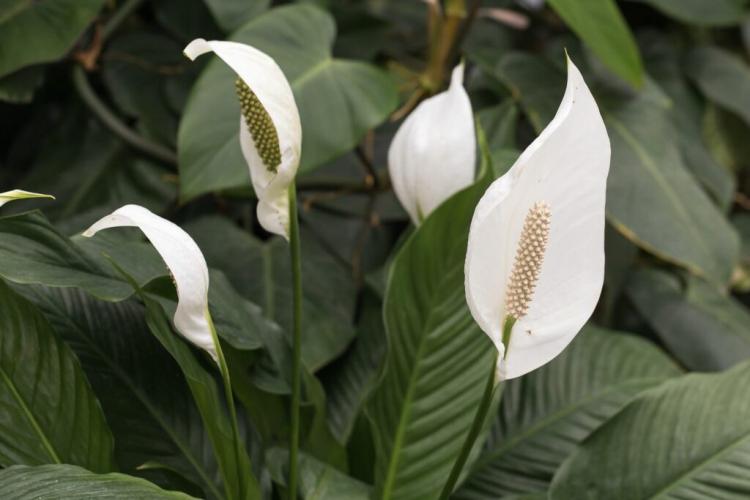Snake Plant (Sansevieria): Expert Tips For Buying, Maintaining And Propagating Mother-In-Law’s Tongue
Snake Plant is a popular indoor plant. Here you will learn everything you should know about buying, planting, care, and flowering. The Snake Plant (Sansevieria), or Mother-in-Law’s tongue, is an air purifier and style object in offices, bedrooms, and apartments. The versatile survival artist shows itself in the most beautiful shades. Here you will find all the important information about the plant.
Even if you may not believe it, at first sight, this easy-care indoor plant belongs to the asparagus family (Asparagaceae) and is even related to the dragon tree (Dracaena). Snake Plant is a succulent plant that gets by with little water. Its elegant growth and air-purifying effect make it particularly popular.
Since it produces oxygen at night due to its succulent metabolism, Snake Plant is the optimal plant for the bedroom. In our special article, you will find an overview of the top 10 air-purifying plants.
Snake Plant: Origin And Characteristics
Table of Contents
Desert and savannah landscapes are his home. Originally, the robust Sansevieria comes from various regions of Africa and Asia. Its succulent leaves are supported by woody fibers that give it its American name Mother-In-Law’s tongue. These fibers were used to produce ropes and textiles, similar to the fibers of sisal and the plant.
Snake Plant is characterized by its succulent leaves that rise skywards and sprout from the ground, either singly or in rosettes. A height of 1.5 meters, depending on the species, is not uncommon. However, it takes a long time for the plant to reach this size. As an easy-care indoor plant, the Sansevieria was discovered early on and so it exists in the most diverse cultivations.
Does Snake Plant Also Bloom Here?
To see the blossom of your own Sansevieria is something special and a not too frequent event. Every single shoot of the plant blooms only once in its life. To do this, the Mother-in-Law’s tongue, must feel very well and be a little older. But with the right care and a lot of patience, you have a good chance to experience the flowering. This happens mainly in March.
The whitish, greenish, yellowish, or even pinkish flowers are arranged in upright inflorescences and have an intense scent. Since the small flowers produce quite a bit of nectar, you should put an old newspaper or something similar under the pot to avoid a mess.
However, for seeds to develop after flowering, pollination by moths is necessary. In your own four walls, this is probably not possible, but maybe it works if you help a little with a brush and thus play the pollinator.
Snake Plant Varieties
More than sixty types of Sansevieria are now known. But only a few of them have made it into our homes as varieties in various breeding forms. We have listed some of the most important species and their varieties below:
- Sansevieria trifasciata: The best known and most popular species of the Snake as a house plant is undoubtedly the species Sansevieria trifasciata, which originates from tropical Africa. Its broad leaves are marbled in light green, dark green, and grey-green colors. You will certainly have encountered the variety ‘Laurentii’ before. It is similar to the wild form, but its leaves have a very decorative yellow-green edge.
- Sansevieria cylindrica: Originating from the dry savannahs south of the Sahara, this species is now also triumphant in our interiors. Sansevieria cylindrica has cylindrically shaped leaves that correspond to its name. These are rather light green to green-greyish and have dark green horizontal stripes. Similar to the wild form, only a little greenish-yellow, is the variety ‘Variegata’. The leaves of the variety ‘Boncel’ do not grow as straight upwards as typical for Sansevieria cylindrica but spread fan-like to the side. It is precisely this species that is offered in the trade in a very different and varied manner: Vertical leaf cuttings, interlaced, with colorful caps, and much more. However, all these arrangements are not species or varieties, but only creative ideas of marketing experts.
- Sansevieria francisii: This species also has rather cylindrical leaves, which, however, grow upwards in an almost stem-shaped manner, building on each other. As the stem-like formations become longer and longer and it becomes more difficult to keep them upright, the plant lies down and continues to grow while lying down.

Planting
Snake Plant comes from dry and sunny-hot semi-deserts. The soil there is sandy, stony, hard and, on top of that, poor in nutrients. You should absolutely pay attention to this when planting. As a substrate, you can use cactus soil. It is important that the substrate has good permeability for water and is rather low in nutrients. Alternatively, you can also keep your Snake Plant in hydroponics with clay granules. The pot should have a drain hole to allow excess water to drain away. As additional drainage, you can also put some fragments of clay at the bottom of the pot.
Since Snake Plant is a slow-growing plant, you only need to repot it every few years. The best time is in early spring. Choose a pot that is only slightly larger than the old one.
You Might Also Like Do Snake Plants Attract Bugs?
Summary Planting:
- Repotting only every few years in spring
- Use cactus soil or a garden soil-sand mixture as the substrate
- Pot with drain hole and possibly drainage layer of clay fragments
Planting: The Right Location
The Sansevieria likes extremes: a lot of suns, a lot of heat, a lot of dryness. If possible, give it a bright and warm place. Although it gets by with a little less light, it grows faster and more colorful in the sun. Direct sunlight does not bother it at all and it gets along well even with little humidity. In summer, it also enjoys a little fresh air outside in a sunny and dry location. As with other plants, Sansevieria must be slowly accustomed to direct sunlight to avoid sunburn. In late summer, however, you should bring it back into the house in time. Make sure that it never has to endure temperatures below 10°C in winter. Even better, he will be nice and warm at over 15 °C.
You Might Also Like How Much Sunlight Does A Snake Plant Need?
Care For Snake Plant
With the Snake Plant, you get an easy-care roommate into the house. He is used to drying periods from his home and so he prefers it to be too dry rather than too humid. It also prefers to be fertilized less than more. To kill the Snake Plant, it needs already much. But if it is to flower, it should not only be alive but also feel good as a poodle.
Tips For Propagation By Division & Cuttings Snake Plant
Snake Plant can be propagated quite easily. We show you what you should know about the propagation of the plant by cuttings or division. The Sansevieria is not only a good air purifier and extremely easy to maintain, but it can also be propagated easily. With the right knowledge, you can set up small mass production in no time.
Snake Plant clearly belongs to the type of plants that can be propagated endlessly. Especially the two popular species Sansevieria trifasciata and Sansevieria cylindrica can never be enough. Although the plants do not grow very fast, they form new offshoots with young daughter rosettes all by themselves. You can also easily grow many small plants from the leaves.

Propagating Snake Plant Through Cuttings
Snake Plant can be propagated well by leaf cuttings. To do this, cut off a leaf just above the bottom. It is best to choose a leaf that is still small so that the cuttings are not too large. Long leaves can also be divided into several parts because the individual cuttings only need to be ten to fifteen centimeters long. Let the cuttings dry out a little. Now you can place about one-third of each leaf or leaf part in the prepared substrate.
You Might Also Like : Can Snake Plants Live Outside
Make absolutely sure that you place the leaf parts in the soil the right way round. Roots will only grow if they are allowed to continue growing in their original direction. The cuttings need a lot of time to develop, and it can even take several months before the small plants appear. Place the planter in a warm place and keep it moist, but not wet.
Summary Propagate Snake Plant with leaf cuttings:
- Cut small leaf just above the ground.
- Divide into 10 – 15 cm long pieces of leaves.
- Insert one-third of the leaf cuttings in the direction of growth in the substrate.
- Place the planter in a warm place and keep it moist.
The disadvantage of leaf cuttings is that the young plants can deviate from the breeding form of their mother plant. This is the case with Sansevieria trifasciata ˈLaurentiiˈ. It can happen that the plants develop back to their original form and lose the yellow leaf edge.
Propagate Snake Plant By Division
Repotting is the ideal time to propagate the plant quickly and easily. With runners, breeding forms that can be lost via cuttings are also preserved. When you take your plant out of the pot, you will notice that it is usually no longer just a single plant. Over time, the Snake Plant has formed runners whose daughter rosettes you can now remove. Disentangle the intertwined roots and carefully separate the plants from each other. With a sharp and clean knife, you can cut off the young plants close to the mother plant. Now you have one or more young plants that you can pot separately.

Are Snake Plants Toxic To People, Cats, And Dogs?
Again and again, the question arises whether the Snake Plant can become dangerous for children and pets. We clarify whether the Snake Plant is poisonous or not. Sansevieria is not quite innocent, because this drought-loving plant is considered to be slightly poisonous. It is not alone with this, because numerous other popular indoor plants are classified similarly. But what exactly does this mean in practice for your child or pet?
Like so many plants, Sansevieria must also protect itself. Otherwise, it would quickly end up in the stomachs of hungry animals in its inhospitable home, where it is quite alone with its greenery. Since spiked Snake Plant is not so far-fetched and, as is well known, is not effective against animals like insects anyway, the plant relies on a chemical defense strategy.
Is Snake Plant Poisonous For Humans?
The term “saponins” probably sounds potentially poisonous at first – and this is actually the case. Snake Plant is a slightly poisonous plant. However, you don’t need to immediately stop growing it, because saponins are also found in tomatoes, spinach, soap nuts, and horse chestnuts. The saponin contained in all parts of the plant is a hemolytic sapogenin, which can lead to a decomposition of red blood cells in case of an overdose. But as is well known, it always depends on the dose. For adults, Sansevieria is certainly not healthy, but it does not cause further damage.

In children, on the other hand, symptoms such as nausea, vomiting, diarrhea, and cramps can occur. Serious damage is very unlikely, however. If severe symptoms occur, you should nevertheless contact the Poison Emergency Hotline immediately for safety reasons.
Is Snake Plant Poisonous For Cats?
What is slightly poisonous for humans can become a danger especially for small animals. For dogs, Sansevieria is therefore classified as slightly toxic. The same is also true for cats. Animals of this size show similar symptoms to humans, i.e. vomiting, cramps, and diarrhea. In severe cases, you should contact your veterinarian.
Snake Plant can be really dangerous for small animals like rats and mice. The small rodents can die if they ingest too much of the plant. Whether rats and mice are really interested in gnawing on a piece of Snake Plant is questionable, but keep the plant away from them for safety’s sake.
Treat Sansevieria Poisoning
Here in all brevity the most important to the procedure, if a child or a domestic animal a piece of Sansevieria:
- Remove any plant remains from the mouth.
- Never try to induce nausea.
- Rinse mouth with still water or tap water.
- If symptoms occur, contact the poison emergency call or, in the case of pets, the veterinarian.
Buy Snake Plant: Guidebook & Recommended Sources Of Supply
To ensure that you can enjoy your houseplant for a long time, you should be careful when buying it. We show you what you need to pay attention to when buying the plant. Sansevieria is no longer a dusty house plant of past decades. The diverse plant can come up with the most different species. Whether cylindrical or flat leaves, monochrome, or with yellow edges – the decision is yours alone.
Sansevieria is a wonderful indoor plant with many advantages. But with so much variety, the decision is not always easy. How you can find the right plant for you, you can find out here.
Buy Snake Plant: What you should consider?
The purchase of a Snake Plant is usually easy. Since the requirements of all species and varieties are relatively similar, you only need to worry about the appearance, because pests rarely attack. If you decide on species with flat leaves like Sansevieria trifasciata, you can usually be guided by the appearance alone.
However, the situation is different for a plant with round leaves like Sansevieria cylindrica. This makes it more difficult because in addition to the different varieties, there are also different cultivars, which are often described similarly to the varieties.
Cultivars of Snake Plant with round leaves:
- Spaghetti: For this purpose, young single plants are planted so close to each other that they grow long and thin, separated from each other, next to each other
- Mikado: This type of culture works similarly, except that the individual cuttings grow somewhat further apart and are therefore thicker
- Musica: Here, the individual plants are planted next to each other in a row of size, similar to a fan or an organ
- Twister: In this form, the individual plants are twisted into a thick plait
It is a good idea to separate such arrangements after purchase and to separate the young plants to allow the individual plants to grow well.
Summary
- Sansevieria species generally have similar demands, so you can be guided by your eye
- The cultivar is not the same as the variety: Mikado, Spaghetti, Musica, Twister, are cultivars and not varieties
- Decorations such as colorful hats harm the plant rather.
- Buy Snake Plant: Recommended sources of supply.
- Snake Plant is available from many suppliers. We can especially recommend the following.






